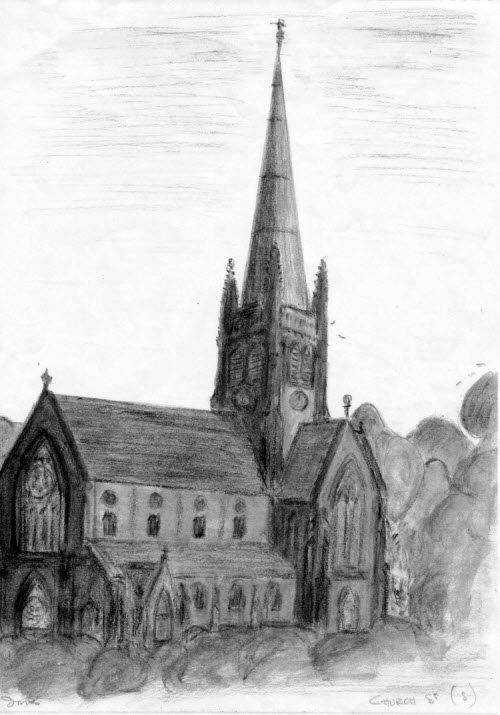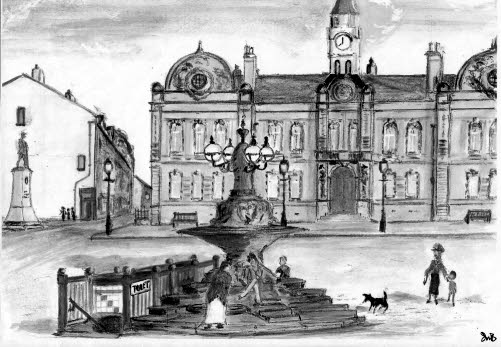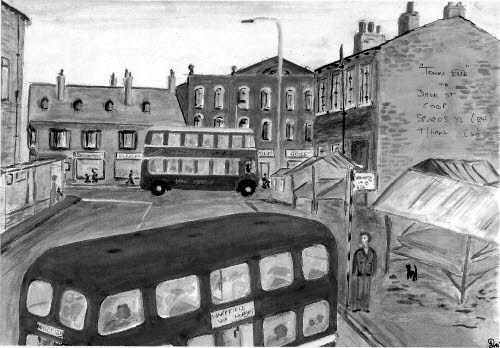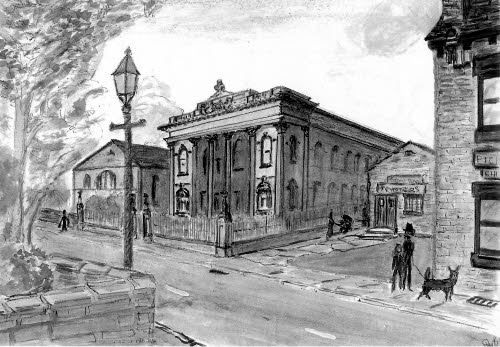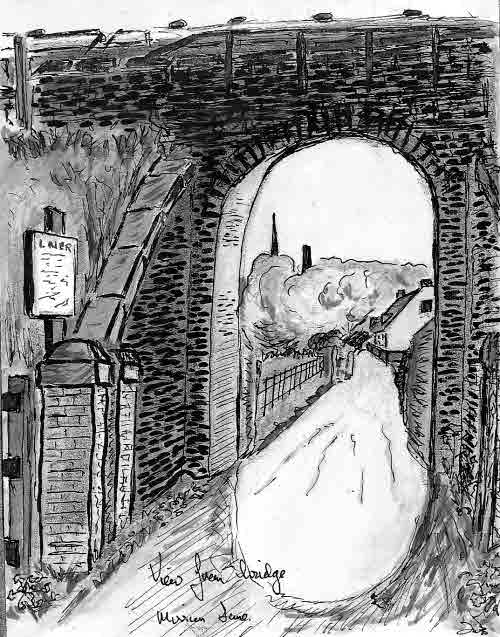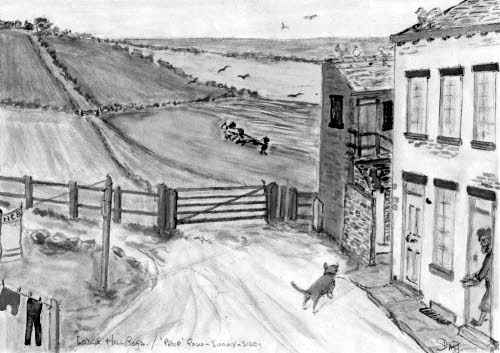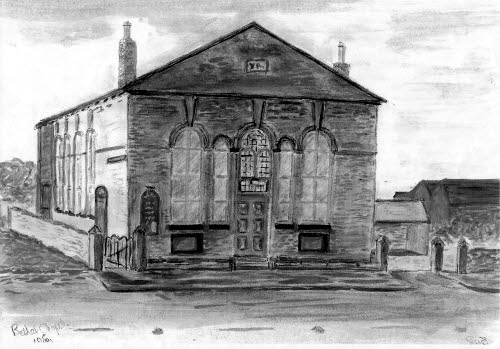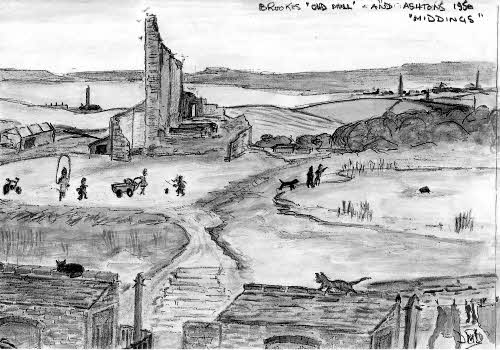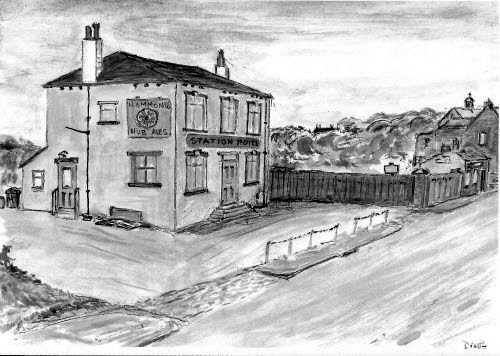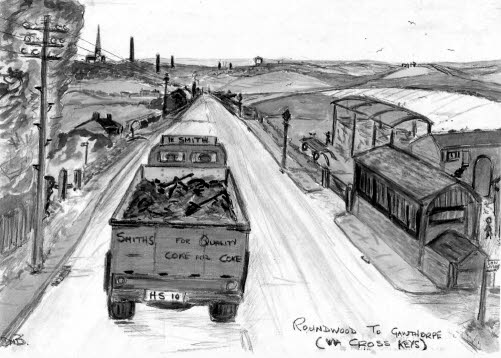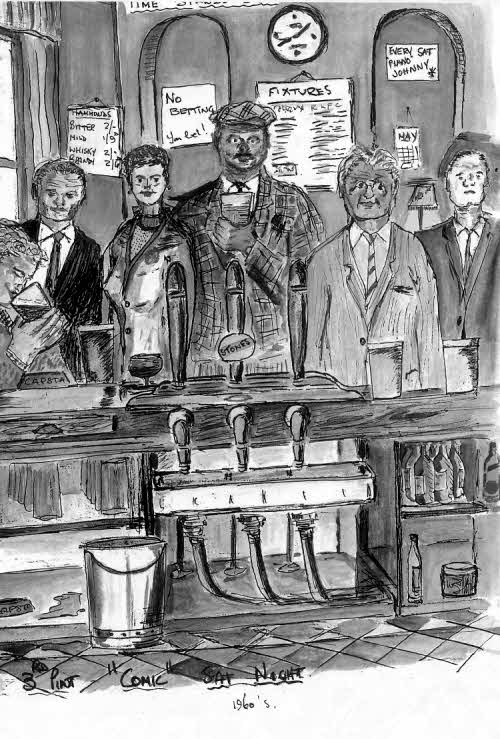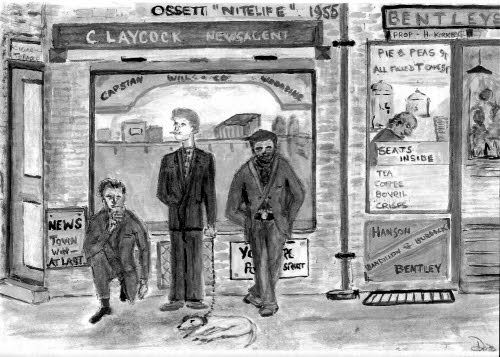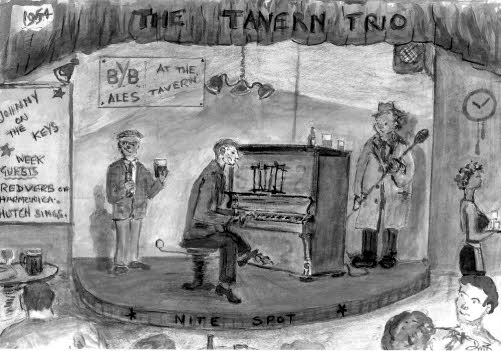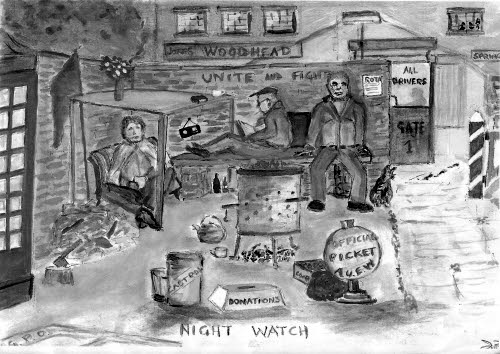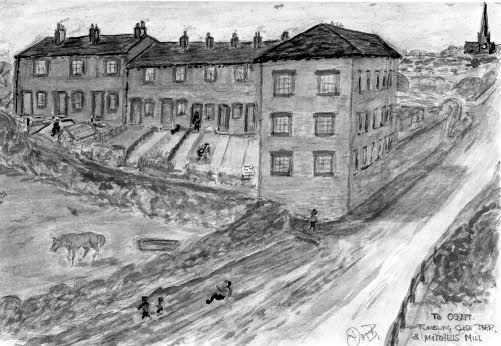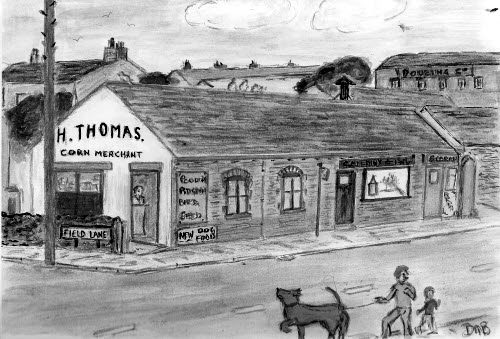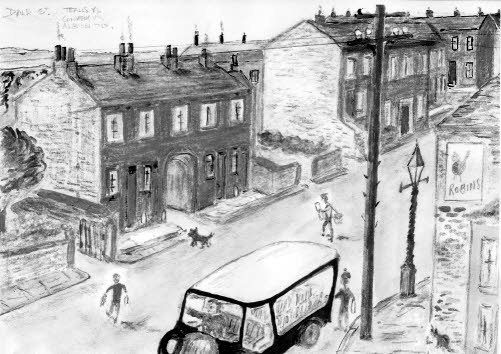Ossett - the history of a Yorkshire town
- ossett :
- Home :
- What's New :
- Picture Gallery :
- WW1 Remembrance :
- WW2 Remembrance :
- Contact :
Ossett Sketches by Douglas Brammer
These 50 unique sketches and drawings of Ossett presented here are part of a number drawn by Douglas Brammer which he has kindly allowed to be reproduced here on the ossett.net web site. Douglas has previously contributed his Flushdyke Sketches to the web site and this series of drawings and sketches covers a wider area of Ossett. All the drawings are done from Douglas' phenomenal memory and show many of Ossett's buildings and scenes that have now changed out of all recognition or disappeared altogther.
Click on any of the black and white pictures below for a larger, colour version, which will open in a new window.
Above: View from Jaw Hill, Flushdyke towards Ossett.
Above: Gawthorpe Water Tower.
Above: Trinity Church, Ossett.
Above: Ossett Grammar SChool circa 1952.
Above: Ashton's Buildings, Flushdyke.
Above: Ings MIll, Dale Street, as seen from Tumbling Close, Ossett.
Above: Ossett Market Square in the 1950s with the Hannah Pickard Fountain in the foreground.
Above: Town End, Ossett in the 1950s.
Above: Palladium Cinema, Ossett.
Above: Wesleyan Chapel, Wesley Street, Ossett.
Above: View towards Ossett from the now demolished Mission Lane bridge.
Above: Lodge Hill from Wakefield Road, Flushdyke, Ossett.
Above: Longlands House, Flushdyke, now demolished.
Above: Tommy Brook's Farm at Longlands, Flushdyke.
Above: Prop Row, Sandbeds, Flushdyke.
Above: The Horse and Jockey public house, Dale Street, Ossett..
Above: Cross Keys public house, Shepherd Hill, Flushdyke, Ossett.
Above: Flushdyke School on the then Park Mill Lane.
Above: Bethel Chapel, Flushdyke
Above: Railway Hotel, Flushdyke, now demolished.
Above: View of the railway line from Park Mill Lane, Flushdyke..
Above: Spring Mill from the footbridge over Spring Beck.
Above: Spring Mill Yard before demolition.
Above: Ruin of Brooke's Old Mill (Whitley Spring Mill) at Flushdyke..
Above:The Red Lion public house, Dewsbury Road, Ossett.
Above: Flying Horse public house, Dewsbury Road, Ossett at the junction with Church Street, now demolished for housing.
Above: The Hammer and Stithy, Wakefield Road, Streetside, Ossett.
Above: Station Hotel, Wakefield Road, Chickenley Heath, now demolished.
Above: The Royal Oak, Owl Lane, Ossett also known as "the Barracks."
Above: Ossett Feast at Gedham Field.
Above: Mason's Arms, now renamed "The Taps", Queen Street, Ossett..
Above: The Commercial on the corner of Horbury Road and Victoria Street was affectionately known as "Jinnies" before it closed.
Above: Roundwood to Gawthorpe on the old Wakefield to Dewsbury Road.
Above: Flushdyke Station.
Above: St. Mary's Church, Gawthorpe, before demolition.
Above: Bonfire in 1990 at the Commercial also known as the "Comic", Dewsbury Road, Flushdyke, Ossett.
Above: Trolley Race at Shepherds Hill, Flushdyke.
Above: Drinking matyes at the "Comic".
Above: A group of Ossett gentlemen at the bottom of Wesley Street.
Above: What is believed to be Sowood Manor House, built circa 1684 and before being demolihsed in the late 1950s, was located on the right of the driveway leading to Ossett Academy..
Above: The Tavern Trio playing at Railway Tavern (The Tavern), Ossett.
Above: Snooker Room, Fern House WMC, Ossett.
Above: Concert at the Bethel Chapel, Flushdyke.
Above: Night watch picket line at Woodhead's factory, Moorcroft Mills, Church St., Ossett.
Above: View across the fileds towards Wakefield from Palesides, Ossett.
Above: Flushdyke in 2012.
Above: Nelly's Well, Dale Street.
Above: Springstone House, at the junction of Springstone Avenue and the Dewsbury/Wakefield Road.
Above: Three-Way and Cattle Gate at Spring Mill.
Above: A view along Littlefield Road towards Ossett Town End from Tattersfield Street.
Above: Tumbling Close Terrace was situated near to the railway bridge, known as the Three Arch Bridge, which stood close to where the Towngate Petrol Station stands today.
Above: H. Thomas, Corn Merchant was located at the junction of Field Lanre and Church Street and is now a pharmacy.
Above: Dale Street showing Teall’s and Conyer’s Yards with Albion Terrace in the background.
Above: Tomlinson's Yard, Dale Street demolished to make way for Ossett Fire Station, which closed in 2016.
Ossett History
- In Utile ex Arte
- Oslaset - Origins
- Domesday & Beyond
- 14th & 15th Centuries
- 16th & 17th Centuries
- 18th Century
- 19th Century
- 20th Century
Ossett Heritage
- Ossett People
- Ossett Academy
- Ossett Spa
- Ossett Water
- Ossett Collieries
- Ossett Houses
- Ossett Mills
- Gawthorpe
- Healey & Millbank
- Low Laithes
- Mark Senior
- Eli Marsden Wilson
- Flushdyke Sketches
- Brammer's Ossett Sketches
- Ossett Virtual Blue Plaque Scheme
Kids Corner
Green Park 
Links
Douglas M. Brammer was born in Flushdyke in 1937 and has lived in the area for most of his life. His father Sydney Brammer was a well-known figure in Ossett, working as a manager at various local branches of the Ossett Co-operative Society after service in the army in East Africa during WW2.
Douglas, an old boy of Ossett Grammar School is now retired from a career first in engineering and later as a social worker. He decided to turn his hand to drawing and sketching in his retirement.
Ossett New Park
From the 13th Century, Flushdyke or at least large parts of Flushdyke was located in the Lord of the Manor of Wakefield's hunting ground, which was called the New Park.
The New Park had a total area of 1,092 acres and measured about six miles all around the periphery. The New Park was fenced to keep people out and the animals in. Of the total area, 757 acres were located within the Ossett boundary and covered nearly a quarter of the total area of Ossett.
The hilltop area to the east of Lodge Hill Farm, overlooking the Flushdyke settlement was where the keeper and foresters of the New Park lived. They enjoyed a virtually uninterrupted view over the majority of the New Park from the hilltop site. In 1305, Adam le Hunter and his son, John le Hunter were retained foresters for the New Park.
The New Park itself was described as "bushy, barren ground; stocked with red deer, fallow deer, hares, rabbits and partridges."

Oak trees from the park were felled to build various manor buildings and in 1241, ten great oaks were given to the Archbishop of York for the construction of the south transept at York Minster. Five further oaks were donated for the construction of Holy Trinity Church in Goodramgate, York.
Tufty Farm
Cinder Hill, meaning iron slag is next to Le Tofts or as it is known now, Tufty Farm. Le Tofts is an ancient Norse name and suggests that the medieval owners of the homestead, which dates back to Viking times, mined iron ore and smelted iron on the site. In fact, iron making was a common industry in the New Park.
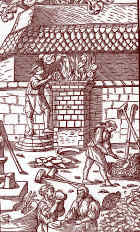
Owlers Farm
It is possible that bricks were made at Owlers Farm. Brick Close, which adjoins the farm at Flushdyke suggests that there must be a connection. Clay, sand (Sandbeds) and coal to fire the kilns were all available locally.

Nettleton & Porter, Fellmongers
This Flushdyke business was founded by Edward Broadhead Nettleton from the well-known Ossett family of butchers. The firm later became Nettleton & Porter.

Burdekins Basket Works
Burdekins Basket Works was first founded in 1870 by Joseph Buredekin and one of their most popular products in recent years was passenger baskets for hot-air balloons. In recent times, the company has been put up for sale.
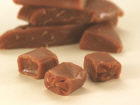
Johnson & Sowerby, Toffee Manufacturers
Flushdyke has had a diverse selection of different businesses over the years, including from 1934 to 1961 the firm of Johnson & Sowerby, Toffee Manufacturers.
In 1928, Harry Johnson and Jack Sowerby started their business as toffee makers in Little Westgate, Wakefield, selling their toffee on Wakefield Market.
These premises soon proved to be too small and owing to rapid expansion of the business, they moved to Flushdyke in 1934 into what had previously been a rag mill. Extensive modernisation was carried out and a modern factory was soon in operation.
Until the onset of WW2, the speciality of the firm was "Violil Toffee"named after the wives of the two principals; Violet Sowerby and Lily Johnson. Owing to a shortage of ingredients, after WW2, "Violil" was discontinued and only a limited range of more traditional toffee was produced.
The factory provided
employment for some of the local women, and before Easter, extra staff were taken on to make fondant-filled Easter eggs. Johnson and Sowerby also made specialist toffee such as banana and licquorice flavour. They also made large mint humbugs that must have weighed 4-6 ounces (100-150 grams).
Just imagine how the local children in the late 1940s and early 1950s regarded the toffee factory. They were a generation who had grown up with rationing that meant an absence of sweets during the war and then for a fair while afterwards.
Rationing did not end in England until midnight on the 4th July 1954, fourteen years after it was first introduced.
After the toffee making business closed in 1961, the premises on Wakefield Road, Flushdyke were taken over by an upholstery firm and latterly Gardners of Wakefield, suppliers of caravan accessories.
Riley's Fireworks
The following is an extract from an old Ossett Trade Magazine from the 1920s and describes Riley's Firework Factory, which was based in Flushdyke.

An Interesting Ossett Industry - Fireworks
For nearly eighty years the firm of Messrs. M. Riley & Sons, of Wakefield Road, Ossett, have been supplying successive generations of schoolboys with that most delightful of possessions, a stock of capital fireworks, and the firm to-day is reputed to be the third largest and one of the most efficient makers of fireworks in the country. The firm was established by the grandfather of the present proprietors, Mr. Michael Riley, an Ossett man, in 1844, and he was succeeded by his son, Mr. Solomon Riley, who continued the business until his death in 1897, when Mr. Mark Ellis Riley, his brother, who was the organist and choirmaster at Ossett Parish Church, took up the principalship until his death in 1904. The present proprietors, Mr. A. V. S. Riley and Mr. S. B. Riley, have taken up the family business with an energy and enterprise, which have brought the firm right to the forefront.
The firm has been responsible for the pyrotechnic displays in some of the best-known galas in the North of England. Messrs. M. Riley & Sons provided the fireworks displays in the Coronation festivities in the principal Northern towns, and during the peace rejoicings in 1919 the firm was equally prominent. In 1913 and 1914 the firm secured the contract for the seasonal fireworks displays at Bridlington Spa. They have a big reputation for their spectacular displays, which illustrate Niagara Falls and the Taj Mahal, and include many comical devices, which are exceedingly popular with the Northern crowds. Messrs. Riley & Sons are well known throughout the Midlands and the North for their admirable provision for the November trade, which now includes not only the Guy Fawkes’ Festival but also the celebration of Armistice Day. It is scarcely credible, but it is nevertheless true, that they manufacture between 250 and 300 different kinds of fireworks, and their manufactures are popular wherever youth foregathers.
Their war service deserves special mention. From August 1915, to the end of the War they were fully employed by the War Office and the Admiralty, and their special knowledge of explosives was extremely useful. They filled as many as between eight and nine million grenades, made red and green square cartridges to the extent of a quarter of a million, and 100,000 parachute cartridges; they were responsible for 6,000 smoke boxes for the Admiralty, and for three thousand deck flares which were used as smoke screens, especially by merchant and passenger ships. That is a war record to be proud of. Since the Armistice the firm has gone back to the normal pyrotechnic and fireworks trade.
However, despite the optimistic words above, disaster was to ruin this Ossett business and cause it to close overnight. The 'Ossett Observer' for August 20th 1927, had the following story:
"Terrible Explosion at Ossett Fireworks Factory"
"A terrible explosion resulting
in three deaths occurred shortly after seven o 'clock last (Friday) evening (19th August 1927) on the premises of Messrs. Riley and Sons, firework manufacturers of Wakefield Road, Ossett.
The explosion, the cause of which cannot at present be explained, took place in the chemical shed, one of the several detached buildings where the firm's work is carried on. Four persons were working at the time, these being Messrs. Arthur Victor Sheldon Riley (the proprietor); Fred Ward and F. Bottomley (employees), all married men and residing in Springstone Avenue and Mr. Harvey Sheldrake.
Mr. Riley was alive when picked up, but died before his removal. The two others were dead when found outside the building, which was completely shattered by the explosion. Mr. Harvey Sheldrake was in an adjoining shed and escaped personal injury, though he was obviously suffering from shock. The effects of the explosion were felt in various parts of the town and windows were smashed in the Fern House Working Men's Club, in Wakefield Road, opposite Messrs. Riley's works.
Ossett Fire Brigade and Ambulance were quickly on the scene after the alarm, one length of hose being sufficient to prevent the possibility of fire. We understand that the injuries were of a terrible nature and two of the bodies (those of Ward and Bottomley) being practically dismembered. Death was obviously instantaneous in their case. Mr. Riley, whose injuries appeared to be in the lower part of the body, lived 10 or 15 minutes after the occurrence.
The explosion was so terrific that people in all parts of the town immediately rushed into the streets to inquire the cause, and when the fire 'buzzer' was heard shortly afterwards, people wended their way, as if by intuition, in the direction of Riley's factory. Within a comparatively short space of time a huge crowd had gathered on the scene, regardless of the danger of close proximity to buildings of that nature and it was with some difficulty that they could be induced to stand clear. It was fortunate that there was no outburst of flames, but as a precautionary measure, the brigade saturated the remains of the wreckage. The building was practically razed to the ground, and the contents were scattered in all directions. The force of the explosion can be imagined from the fact that two of the bodies were found outside the area of the building, whilst windows were broken in a house in Tumbling Close, some 600 yards away.
The tragedy cast a gloom over the town, all the victims being well-known and highly esteemed. The deepest sympathy is felt with the families of the deceased men in their sad bereavement. Each of the victims leaves a widow and one child."
![]()
Team 17
Games and software specialists, Team 17 Software Ltd., is one of the more modern companies to have moved to Flushdyke. Originally, they had premises on Prospect Road in Ossett. They took over larger premises originally built for electrical contracting firm East Midlands Electricity, which was built roughly where Longlands House has stood previously.
During their 16 years of operation Team 17 have created over forty titles and over 130 releases on 16 gaming formats. There are approximately 70 staff mostly based at Longlands House, Flushdyke, developing games titles for current, next-gen, digital platforms and handheld technology.
The major breakthrough title for Team 17 was Worms released in 1995 - which was a huge hit on all systems, making UK number one in the 'All Formats' chart and going on to become one of the worlds' most revered game-franchises, now in its 10th year with the release of Worms Open Warfare in the spring of 2006.

These days, Team17 are working with an impressive collection of top-line publishers, developing a range of both original IP and licensed video games on an exciting range of systems and platforms. Our management team is always happy to discuss new projects and opportunities as they occur.


